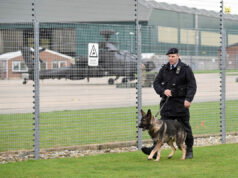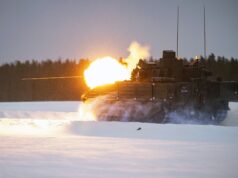The British Army has been demonstrating its new In-Service Physical Employment Standards for all ground close combat roles which will come into effect from 2019.
The Army say that current policy on physical employment standards hadn’t been changed for 20 years and needed updating. According to a statement:
“These new physical fitness standards are objective, measurable, role-related and gender-free to ensure Army personnel have the physical capability to meet the necessary force preparation and operational requirements.”
PES will be incorporated into a new structured suite of Army Role Fitness Tests – a series of tests to assess whether personnel are fit for a specific role.
The new tests aim to replicate combat scenarios by mimicking real-life tasks.
Tests will include casualty extraction from a vehicle, repeated lift and carry and fire and manoeuvre. The standards are based on detailed analysis of roles, with the scientific research being conducted by the University of Chichester.
Under the new system soldiers will have to do a 4km march carrying 40kg of equipment in less than 40 minutes, followed by a 2km march carrying 25kg of equipment in under 15 minutes. Soldiers will then have to complete a fire and move exercise in less than five minutes, followed by a 20m drag of a 110kg weight.
They will then have to carry two water cans weighing 22kg each over 240m in under four minutes, followed by lifting a 70kg weight and holding it for three seconds. Finally soldiers will have to carry bags weighing 20kg 20 times over a distance of 30m.
Field Army Sergeant Major Gavin Paton was quoted as saying:
“I don’t care if you are a man or a woman, I don’t care what you do, and the enemy doesn’t either.”














How does this compare to previous standards….one gets the feeling this is being watered down for various reasons….
Peter wrote:
How does this compare to previous standards….one gets the feeling this is being watered down for various reasons….”
The Army has Military Annual Training Tests and PT is MATT2 in a nutshell the tests (as they still are) are engineered for the role you have. So a Infantry soldier will have to undertake a much harder fitness test than a clerk, it is also age specific, so the older you become the less you have to do (it also used to be gender specific, but as mentioned above that has now been done away with) The last time the army brought in gender free training we lost a lot of female recruits in basic due musculoskeletal injuries ( from what I personally saw, shin splints due to boot wearing) However after a few years that was quietly binned and the fairer sex ended up carrying less weight, and doing less as in sit-ups, press ups .
This new test came about when Fallon was defence sec in 2016 and lifted the ban on women serving in close combat units without looking at the new MATT I cannot say if the standards have been watered down. However that said 4kms carrying 40Kg for teeth arms will remove a lot of female applicants seeing as Teeth arms currently have to carry 25kgs for 8 miles.
So that tells me that the powers that be, have ensured that standards will remain high.
Just to correct you… females do not carry less weight on AFT or have to do any less sit ups on PFA, they do however have less press ups to do.
what was wrong with the BFT and ICFT worked for years or is the army going (a) soft again or (b) fixing something that was not broken
Hi Andy,
I just saw your comment and wanted to provide a response to explain the rationale behind the recent changes. Numerous studies have shown that soldiers experience overuse injuries at a high rate—about 58% during basic training, with an increase once they reach their battalions. After extensive research, testing, and analysis of key physiological factors, we’ve developed a series of assessments aimed at significantly reducing musculoskeletal injuries (MSKIs).
This approach isn’t about “if it’s not broken, don’t fix it.” Instead, ongoing studies are crucial to ensure soldiers and the military as a whole receive the most effective training to minimize injuries. As you’re aware, preventing these injuries not only preserves soldier health but also reduces associated costs.
That is a very low bar they are setting. Are they planning on getting recruits killed due to poor fitness or is it just stupidity? A 4K march in 40 minutes!? You can almost do that on crutches.
This is a give me test to the politically correct and will result in lack of preparedness.
Carrying 40 kg.
40 kg is not very heavy for front line soldiers
What? How can you say that, this test is insane. Most humans can’t even walk 4k with 40kg. Yiu must be son of Rambo
35 miles is about 55-60 kilometres forgot to add the conversion
A disgrace nothing short of total and utter horse manure , a complete joke it’s like what the polis in scotchland did with entry fitness test 5.5 bleep test !!!!! You can pretty much walk that without breaking sweat, level 5 used to be considered the warmup stage a couple years ago! Now the forces are at it all in the name of diversity and trying to get women and overweight fat blokes through , when are they going to learn war is not a game it’s not diversity challenge ! This country is a joke , those leading us are a joke and as far as I’m concerned the people of this once great nation deserve the government and leaders they get …
All, this new test is harder than the monthly BFT and annual fitness tests of old/current. You should try what they are introducing and then make a judgement. What is more telling is that the tests are only for Infantry and Cavalry. It should involve any unit, as every able body in the army goes onto the front line (arty, engineers, logistics, signallers, Intelligence etc.). That this is not the case (AFAIK) is telling.
Thank you, finally someone with human fitness
Me and my brother did it .I am 63 he is 52 .It was too easy way too easy
There are various issues relating the to new tests outlined above that we could usefully explore, however the one that strikes me as a particular challenging relates to the 40 Kg loaded march. Young women weighing say 55 or 60 KG are being expected to speed march 2.5 miles carrying loads averaging something like 70% of their own body weight. Apart from the occasional Amazon this seems to be a recipe for a feast of lower limb injuries.
Well then they need not apply for that specific role. Tests are tests. They’ve been done and studied, and set them as the standard fitness level. If you cant hit the standards, that have no doubt been reduced to make them fairer across the board, then that isn’t the fault of the army’s, it’s the fault of the recruits expectations.
Did you say “reduced to make them fairar”?
“reduced” from what?
Reduced from what you would call a true test to what is now a JOKE .
They’d have to do it in combat, so should have to do it in training…same for everyone
If they want to be in combat they have to meet the requirements, no?
Yes David you are quite right and they may have found that 2.5 miles is the point they can reach before they start getting fatigued to the extent that they incur such lower limb injuries, we don’t know. However for a fit infantryman a forty minute tab even with the extra load seems an easier option than the 8 miler that would normally take 2 hours.
I suspect what is driving these changes is the average load of combat troops, the strength/endurance required to do that, including dragging an incapacitated comrade when both you and they are weighed down with body armour, pouches etc. assuming packs have already been ditched Quoting from ThinkDefence “The average carried weight for Operation HERRICK was a whopping 56kg (123 Pounds)”
As long as we put troops in the field loaded up like this then running (with or without relatively light loads), sit-ups, pushups, pull-ups etc are far less useful as a test IMO for combat fitness versus the new tests. The US Army seems to be going down the same path in terms of tests too.
https://www.thinkdefence.co.uk/overburdened-infantry-soldier/
The us army blazed the path years ago with their Afghanistan specific combat fitness test.
We’ve rightly followed suit.
It isn’t uncommon in our infantry for the racing snakes to be put on a pedestal for their sub 8min PFA only to crumble in combat due to the weight.
The main issue is however (not sure if this will change ) failing fitness tests no longer are valid reasons to boot out unsuitable recruits.
Fitness is a valid reason to refuse recruits .Even the Catering Corp should have to pass
Remove Jeremy Guscott & Jonny Wilkinson & replace with Jenny Guscott & Jeany wilkinson you think France will win more or less 6 Nations matches….
we are doomed….
Having recently re-read a few books regarding the Falklands conflict, and the overland march to Stanley – somewhat forced upon the task force due to the lack of helicopters, I wonder how a similar task force, perhaps with 10-15% female ground troops would fair?
The other question I have, as it is frequently raised when Ministers ans Senior Officers discuss getting more females into the forces – is why do the military forces ”have to reflect society”? – I personally don’t care less whether or not the Army/Navy?Air Force ”reflect society” or not – I want them to be the most effective fighting force possible to defend our country. If that means mostly young male and white with a dash of robots – then fine. If it means mostly female and black – again fine.
What was the typically load they were carrying? I know it was impressive, mind-boggling when one also considers the weather, the terrain and the fact that they had to go into very intense combat at the end of it, but I can never remember the actual numbers and I should given what a monumental feat of soldiering it was.
They were carrying the weight of one average woman.
An average women from which country? Not from the UK surely 😉
If I remember correctly it was around 90lb.
If it helps try not to think of it as ‘reflecting society’ so much as not excluding half the population for no good reason. I have seen a good few women who were consistently able to outperform their male colleagues in terms of fitness and have a lot to offer in GCC. Why should they be excluded if they are good enough?
If they are good enough then they could pass the TEST .Not passing the test says they would not be SUITABLE .Easy enough to grasp eh
There have always been exceptions to the rule. The Roman’s had The Lady Legion during the final days of the empire and they carried smaller shields, swords and spears, while Napoleon had the ‘Dandy’ Division that despite not following traditional military protocol successfully fought for Napoleon in several campaigns. Burke’s History Of The Napoleonic Military and Campaigns said “…an officer of the Dandy Division stood out in the crowd. His flamboyant hat at a fashionable angle, his gold embroidered jacket across one shoulder and shirt buttons undone. He would walk into a room with his belt exceptionally tight with trousers pulled also high and tight, finished off with knee high boots polished to offer a reflection. In normal society they were shunned, but their military prowess gained them a respect they could never find in wider society.”
Great idea more division .
The old pre deployment fitnes test was 12mles on day one then 12 miles on day two with kit followed by an assault course in webbing. Then a 3 mile run in webbing on another day.
Not sure about the new tests, will let you know in a few months.
BV
[…] avots […]
For many years the RN was toying with a more practical fitness test that reflected the actual physical jobs undertaken onboard. They had issues with manual handling regs and HSE for the original proposal
To quote the RN
“Physical fitness remains an essential element of Service life that directly influences operational effectiveness. In the RN physical fitness has been defined as the aerobic capacity to meet the demands of generic tasks at sea, including fire-fighting, damage control and casualty handling. ”
So now you do a bleep test or 2.4 k run or walk with a heart monitor and a strength test which is carry 2×20 Kg over a distance of 4×15 meters with the requirement to pick up and place down the load at the start/end of each shuttle. Basically moving AFFF drums.
Not to tense at all.
Sorry everyone that joins the army weather infantry or clerk. Are fighting soldiers first and trade second. There should be no difference in physical training. Looks like the standards are dropping.
HUSSAIN
People are commenting that this test is “a joke” or “Waterd down” you guys must be super fit or on steroids. I can’t believe this test is real. Run 4k (that’s 2 miles if I’m not mistaken) with 40kgs in 40 mins? That’s just to start off with, that’s insane.
What was the fitness test before it was “watered down”?
Not super fit nor on Roids .Even the average joe should be able to do those tests
I hope this message finds you well. I wanted to address some concerns raised by naysayers regarding the British Army’s new In-Service Physical Employment Standards (PES) for ground close combat roles, which came into effect in 2019.The introduction of these standards is not merely a change for the sake of change; it is a necessary evolution based on two decades of experience and research. The previous physical employment standards had not been updated for 20 years, and the Army recognized the need for a system that accurately reflects the demands of modern combat scenarios. As stated, these new standards are “objective, measurable, role-related and gender-free,” ensuring that all personnel possess the physical capabilities required for their roles (Army details new gender-free physical fitness standards for combat roles).One of the key benefits of the PES is its alignment with real-life operational tasks. The tests, which include casualty extraction, repeated lifting, and carrying heavy loads, are designed to replicate the physical challenges soldiers face in combat. This approach is supported by research conducted by the University of Chichester, which emphasizes that fitness assessments must reflect actual job requirements to be effective (British Army Physical Employment Standards – Topend Sports). By focusing on functional fitness and practical exercises, these standards enhance soldiers’ readiness and resilience in unpredictable environments.Moreover, the PES aims to reduce injury risks associated with military training. By establishing rigorous yet relevant testing protocols, soldiers are better prepared physically, which can lead to fewer musculoskeletal injuries—a significant concern within military ranks (Bootcamp Military Fitness Institute). This proactive approach not only ensures operational effectiveness but also prioritizes the health and safety of our personnel.Critics may argue that these standards could be too demanding; however, it is essential to remember that the enemy does not differentiate based on gender or age. As Field Army Sergeant Major Gavin Paton aptly stated, “I don’t care if you are a man or a woman; I don’t care what you do, and the enemy doesn’t either.” This perspective underscores the necessity for all soldiers to meet the same rigorous standards to ensure mission success.In conclusion, the implementation of PES represents a significant step forward in preparing our military personnel for the realities of combat. By grounding these standards in scientific research and practical application, we can cultivate a more capable and resilient fighting force.